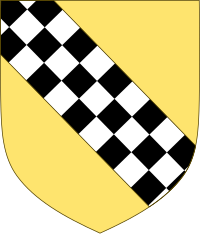John de Menteith
| John de Mentieth | |
|---|---|

|
|
| Personal details | |
| Born | c.1275 |
| Died | c.1329 |
Sir John Menteith of Ruskie and Knapdale (c. 1275 – c. 1329) was a Scottish nobleman during the Wars of Scottish Independence. He is known for his capture of Sir William Wallace in 1305 and later joined with King Robert I of Scotland and received large land grants in Knapdale and Kintyre for his service.
John was the younger son of Walter Bailloch Stewart, and Mary, Countess of Menteith, the daughter and heiress of Walter Comyn, Lord of Badenoch jure uxoris Earl of Menteith. John possessed the land of Ruskie in Stirlingshire. John was a party to the Turnberry Bond with his father, Walter Stewart and the Bruces, which was signed at Turnberry Castle on 20 September 1286.
With his older brother Alexander, John was involved in the resistance against King Edward I of England and were both captured after the Battle of Dunbar on 27 April 1296. While Alexander was released after swearing fealty, John remained a prisoner at Nottingham Castle in England until August 1297, when Edward released John from prison, on his taking oath and giving security to serve with the king in the campaign of 1297 in Flanders.
He was appointed the Constable of Lennox and was ravaging the lands of Edward's partisans in Lennox in 1301. John was sent in 1303 to treat of peace with the English, but refrained from pressing his mission. By 1303 John submitted and had been restored to Edward's favour, for on 20 March 1304 John was appointed Warden of the castle, town, and sheriffdom of Dumbarton. Edward was keen to secure the fortification as a major access route into Scotland by sea. John, as sheriff of Dumbarton, captured Sir William Wallace in 1305 and handed him over to the English. For this John was labeled traitorous and was given the contemporary nickname Fause Menteith ("Menteith the treacherous, false").
...
Wikipedia
